The Apparel Re-commerce Market is estimated to be valued at USD 139.5 billion in 2025 and is projected to reach USD 1258.3 billion by 2035, registering a compound annual growth rate (CAGR) of 24.6% over the forecast period.
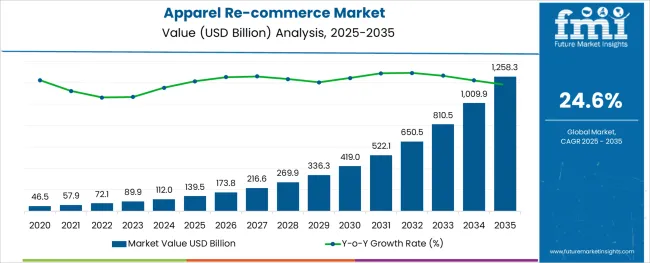
The stainless steel valve tag market is expanding steadily as industrial sectors prioritize asset management, safety compliance, and equipment traceability. Increasing investments in infrastructure and process automation have heightened demand for robust and clear identification solutions capable of withstanding harsh environments.
The shift toward digital transformation in industries such as oil and gas, manufacturing, and utilities is encouraging the adoption of advanced tagging systems that support maintenance and audit operations. Growing awareness around regulatory compliance for equipment labeling and enhanced safety protocols is also influencing market expansion.
The rise of e-commerce platforms has facilitated easier procurement of valve tags, increasing accessibility for small to medium enterprises and broadening geographic reach. Material innovations and customization options continue to enhance product longevity and visibility, creating opportunities for market penetration across diverse industrial applications.
The market is segmented by Company Tier, Product Type, and End User and region. By Company Tier, the market is divided into Tier-1 Companies, Tier-2 Companies, and Tier-3 Companies. In terms of Product Type, the market is classified into Clothing and garments, Footwear, Accessories, Handbags, and Others. Based on End User, the market is segmented into Adult and Kids. Regionally, the market is classified into North America, Latin America, Western Europe, Eastern Europe, Balkan & Baltic Countries, Russia & Belarus, Central Asia, East Asia, South Asia & Pacific, and the Middle East & Africa.
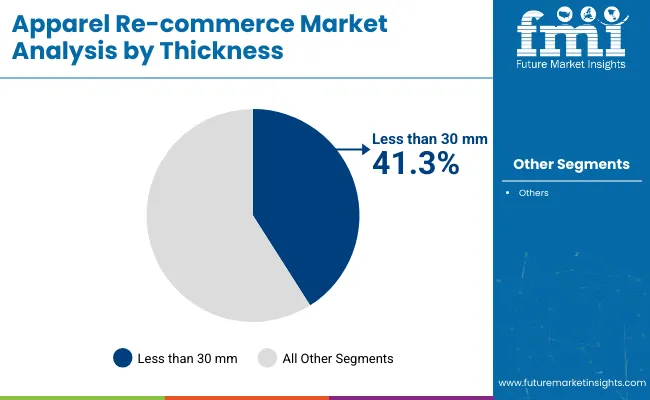
The less than 30 mm thickness segment is expected to hold 41.3% of the revenue share in 2025 within the thickness category. This segment’s leadership is supported by its suitability for a wide range of valve sizes and equipment types, providing sufficient durability while minimizing material costs.
The thinner tags offer flexibility in installation, especially in tight spaces and complex piping systems, making them preferable for industries where compactness is critical. Their compatibility with standard mounting hardware and ability to endure corrosion and wear have reinforced demand in sectors emphasizing both performance and cost efficiency.
This balance between robustness and adaptability has contributed to the segment’s dominant position.
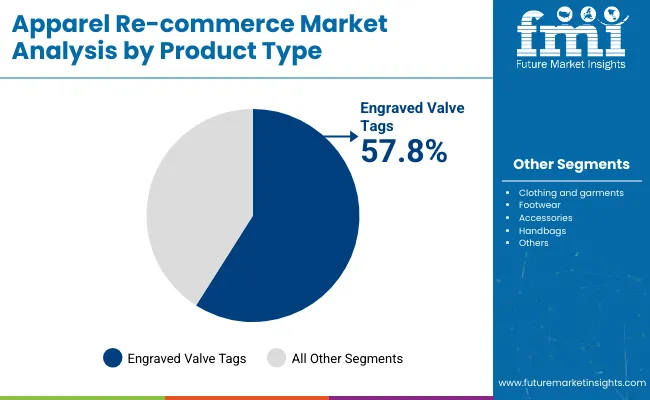
Within the product type category, engraved valve tags are projected to command 57.8% of the market revenue share in 2025, marking them as the leading product form. The prominence of engraved tags is due to their superior legibility, permanence, and resistance to environmental degradation such as fading, scratching, and chemical exposure.
Engraving allows precise and customizable marking, meeting stringent industry standards for traceability and safety. The technique supports complex information including serial numbers, barcodes, and QR codes, enhancing integration with digital asset management systems.
Manufacturers’ emphasis on delivering long-lasting, tamper-proof tags that reduce maintenance costs has reinforced the adoption of engraved tags in heavy industries.
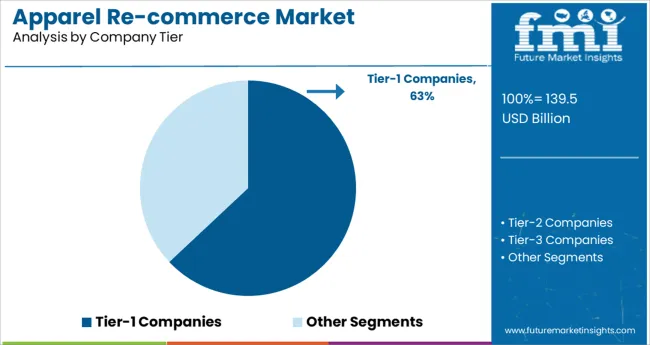
The online distribution channel is expected to generate 63.7% of market revenue in 2025, making it the most dominant sales route. The growth of e-commerce platforms has revolutionized procurement by offering convenience, broader product selections, and competitive pricing to end-users across industries.
Online channels enable buyers to access detailed product specifications, customization options, and customer reviews, simplifying purchase decisions. This has particularly benefited small and medium-sized enterprises lacking traditional supply chain networks.
Additionally, digital platforms have streamlined order fulfillment and reduced lead times, fostering faster adoption. Vendors are increasingly investing in online marketplaces and direct-to-customer websites to expand reach and improve customer engagement, reinforcing the online channel’s leadership in the stainless steel valve tag market.
The apparel re-commerce markets are giving customers an opportunity to own their desired clothes and fashion accessories at affordable prices and without leaving the house. There are multiple facilities provided to the customers, including showcasing the products on sale. The online website has images and product information, which helps educate the customer about the product.
Using these as a reference, customers can choose the size, color, and other choices for their desired products. There is also a peer-to-peer marketplace, where customers can compare the prices of the same or similar products on sale over different marketplaces or websites.
Along with ease in shopping, customers can also connect to the seller directly, if they have any queries or issues related to the product. The apparel re-commerce business is growing as a result of how simple online buying is.
Many companies and manufacturers have entered and invested in the re-commerce sector as a result of the market's overwhelmingly positive response, offering a number of apparel combos, luxury goods, and reselling clothing.
Supply and demand for season-specific apparel and accessories, the increasing popularity of branded apparel, and the increasing penetration of customers, especially millennials are helping the apparel re-commerce market grow.
There are some major problems faced by the apparel re-commerce market, that are limiting the market growth in many regions. The first commonly faced problem is the lack of brand loyalty.
Many brands are providing quality products to customers, making sure that they do not go anywhere else. As there are multiple products available all over the market, customers do not prefer any single brand or product. Such competition and a vast number of products then lead to the weakening of brand trust and loyalty.
Some of these products are provided by counterfeit manufacturers. These products are relatively cheaper, but they also lack quality. This is another reason for weakening the trust between a brand and its customers.
High return rates of the sold products are another problem faced by the re-commerce market. when the customer is not satisfied with the product or receives the wrong product, they can return that product to the seller. There are different policies on returning the products, differing from seller to seller.
Due to freedom for returns in specified days, users are exploiting these policies and returning products after using them for a few days. Due to such problems, sellers are applying no-return policies on their products, increasing complications for customers. These problems are restraining the apparel re-commerce market.
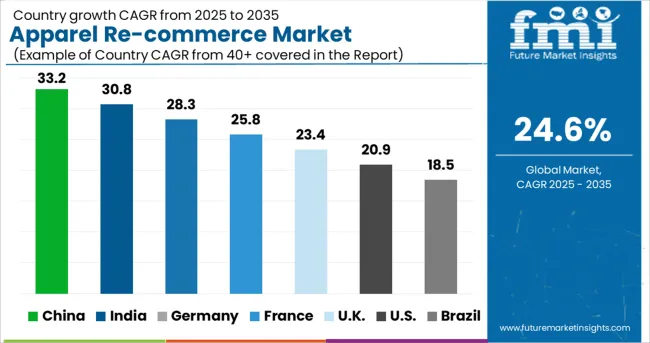
Millennials and Generation Z in the USA are interested in second-hand apparel products. There are multiple fashion trends in the USA and updating one wardrobe from time to time is necessary. At such a time, resale marketplaces are the go-to place for American youth.
Not just apparel and fashion products, there are several luxury products available for resale on these marketplaces. Due to changing lifestyles and increasing environmental awareness, Americans are embracing the apparel re-commerce market.
China is the biggest manufacturer and consumer of apparel and accessories products. There is a number of brands and counterfeit manufacturers, providing different products to customers. Even though, purchasing second-hand clothing at a low price and using them is not attracting Chinese customers.
Chinese customers are ignoring the resale markets, due to their social image and superstitions related to second-hand clothing. Also, fake and counterfeit products are the biggest concern for them. Again, viral infections and health concerns are other reasons that apparel re-commerce is not popular in China.
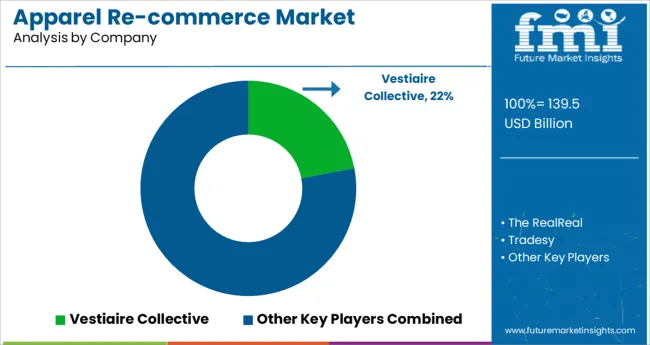
Some key players in the Apparel Re-Commerce market are Vestiaire Collective, The RealReal, Tradesy, Poshmark, ThredUP, Vinted, SnobSwap, Threadflip, and others. These are popular and well-known brands all over the world.
| Attribute | Details |
|---|---|
| Growth Rate | CAGR of ~24.6% from 2025 to 2035 |
| The base year for estimation | 2024 |
| Historical Data Available for | 2020 to 2024 |
| Forecast Period | 2025 to 2035 |
| Quantitative units | Revenue in billion, volume in Units, and CAGR from 2025 to 2035 |
| Report Coverage | Revenue forecast, volume forecast, company ranking, competitive landscape, growth factors, and trends, pricing analysis |
| Segments Covered | Companies, Product Type, End Users, Region |
| Country scope | United States of America, Canada, Mexico, Germany, United Kingdom, France, Italy, Spain, Russia, India, Thailand, China, India, Japan, Australia, Brazil, Argentina, Colombia, Saudi Arabia, UAE, South Africa |
| Key Companies Profiled | Vestiaire Collective; The RealReal; Tradesy; Poshmark; ThredUP; Vinted; SnobSwap; Threadflip; Others |
| Customization scope | Free report customization (equivalent to up to 8 analysts' working days) with purchase. Addition or alteration to country, regional & segment scope. |
| Pricing and purchase options | Avail customized purchase options to meet your exact research needs. |
The global apparel re-commerce market is estimated to be valued at USD 139.5 billion in 2025.
It is projected to reach USD 1,258.3 billion by 2035.
The market is expected to grow at a 24.6% CAGR between 2025 and 2035.
The key product types are tier-1 companies, tier-2 companies and tier-3 companies.
clothing and garments segment is expected to dominate with a 48.0% industry share in 2025.






Full Research Suite comprises of:
Market outlook & trends analysis
Interviews & case studies
Strategic recommendations
Vendor profiles & capabilities analysis
5-year forecasts
8 regions and 60+ country-level data splits
Market segment data splits
12 months of continuous data updates
DELIVERED AS:
PDF EXCEL ONLINE
Apparel Market Size and Share Forecast Outlook 2025 to 2035
Gym Apparel Market Size and Share Forecast Outlook 2025 to 2035
Pet Apparel Market Analysis - Size, Demand & Forecast 2025 to 2035
Chef Apparel Market Size and Share Forecast Outlook 2025 to 2035
Kids Apparel Market Trends - Growth, Demand & Forecast 2025 to 2035
Rugby Apparel Market Forecast and Outlook 2025 to 2035
Blank Apparel Market – Growth & Demand Forecast 2025 to 2035
Bamboo Apparel Market Size and Share Forecast Outlook 2025 to 2035
Outdoor Apparel and Accessories Market Size and Share Forecast Outlook 2025 to 2035
Sequins Apparel Market Size and Share Forecast Outlook 2025 to 2035
TIC For Apparel Market
Crossfit Apparel Market Size and Share Forecast Outlook 2025 to 2035
Maternity Apparel Market Size and Share Forecast Outlook 2025 to 2035
Decorated Apparel Market segmented by Product, End-user and Distribution Channel through 2025 to 2035
Market Share Distribution Among Maternity Apparel Providers
Equestrian Apparel Market Size and Share Forecast Outlook 2025 to 2035
Secondhand Apparel Market Analysis - Size, Share, and Forecast 2025 to 2035
Competitive Overview of Secondhand Apparel Market Share
Second-hand Apparel Market in Europe Analysis - Size, Share, and Forecast Outlook 2025 to 2035
The Dye Sublimated Apparel Market is segmented by product, printing technique, distribution and region through 2025 to 2035.

Thank you!
You will receive an email from our Business Development Manager. Please be sure to check your SPAM/JUNK folder too.
Chat With
MaRIA